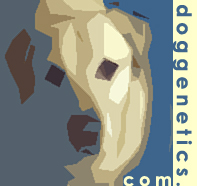
Mating Strategies and Selection Indices: How to Pick Breeding Animals for the Next Generation
Liz Hare, PhD
LizHare@DogGenetics.com
When I was a kid, my family raised Golden Retrievers. Back then the books tried to discourage us from handling the pups a lot, but we couldn't help ourselves. Our puppies were very heavily socialized! We used to hold them, show them to each other, and say ďIím keeping THIS one!Ē This was sort of unfair, because of course we always promised the puppy we were holding that we were going to keep him.
But seriously, how do you decide? How do you decide which pups to keep from a litter, or which stud to breed your specials bitch to on her next heat? You think about the traits you want, and the traits you don't want, right? But does it ever get confusing? Isn't it hard to set priorities?
I don't expect the average dog breeder to use the complex tools that managers of large breeding programs use to choose among hundreds or thousands of animals. But I do think that by understanding how itís done, you can have a framework to think about the decisions you have to make on a smaller scale.
Here are the main selection strategies:
Truncation Selection: Select all animals above or below a particular value for a trait.
Tandem Selection: Select for two different traits in alternating generations.
Index Selection: Selection using an index equation, the subject of the rest of this article
Basically, a selection index is an equation that we use to decide who to breed. This kind of tool is usually used when we are looking at quantitative traits those that vary along a continuum like PennHip score, but they can be used with discrete traits too. To construct a selection index, we have to think about two concepts: which traits to include and how much weight to give each one.
Suppose I want to design a breeding program for Golden Retrievers, and I want my dogs to be good field dogs. I decide that I want to have healthy dogs. Before I even start thinking about an equation, I decide that I will eliminate all candidates who have heart murmurs and eye problems like cataracts (this isn't meant to be an exhaustive list of all the problems we can find in Goldens; itís just an example). There are other health traits that we want to consider that vary along a continuum. Letís use PennHip score as an example. Then, we want to have a measure of a dogís working ability. Letís say weíve devised some test to give a dog when heís two years old to evaluate his capacity as a field worker (in real life, you might do something like use working titles to represent different levels of field work capacity) and that test results in a score from one to ten, with one being ďWhatís a bird?Ē and 100 being a perfect performance.
So we decide that our equations will be:
Dogís Value = PennHip Score + Working Ability Score
We can see that using this formula, dogs with good scores on both their hips and their performance will have the highest numbers, and those with low numbers will have low values. You pick the dogs with the highest values. The equation has given you a sort of yardstick to compare dogs, once you've decided whatís important.
But wait a minute, you say. You've been breeding goldens for 20 years, and over the years their hips have gotten way better. Hip dysplasia is no longer as much of a concern, but you still want to improve working performance. You decide that in your equation, working ability is now twice as important as hip score.
Dogís Value = PennHip Score + [2 times Working Ability Score]
Your selection index equation can change over time to reflect your changing priorities. Even if you don't strictly use the equation, thinking about one can help you decide what traits to include, and how much to weight them. If you run a large breeding program, the equation is the way to go because thereís just too much to keep in your head at once as you look at all the dogs and their traits. There are statistical models that can help determine an animalís value based on his relativesí performance in addition to his own. And you can even use the models to predict the value of a puppy before heís born, or before a mating is done. So with a bunch of statistics, you can decide which breeding is more likely to result in pups with higher values. The average breeder doesn't have enough animals to get statistically significant results with studies like this, but using a selection index equation can really help you think about your priorities and their relative importance.